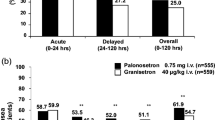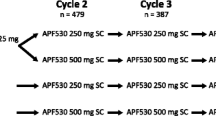Abstract
An open,noncomparative, Nordic multicenter study was carried out during 1991–1992 to evaluate the 5-HT3 receptor antagonist tropisetron (Navoban) as an antiemetic agent for various types of cancer chemotherapy. A total of 630 patients were recruited from 15 centers in Sweden, Denmark, and Finland. Gynecological cancers (60%), breast cancer (15%), and lung cancer (10%) were the main diagnoses. Prior experience of chemotherapy was documented in 338 patients (54%). In 260 patients (41%), cisplatin was part of the cytostatic regimen. Carboplatin (23%), doxorubicin (27%), and epidoxorubicin (24%) were also frequently included. In all, 23 cytostatic agents were used in various combinations. The mean number of courses studied was 4.6 (range 1–19). Altogether, 394 of 619 evaluable patients (64%) were completely protected from acute nausea and vomiting during the first course of chemotherapy. Delayed nausea and vomiting were completely prevented in 45%–73% (days 2–6) in the complete series. Treatment efficacy remained stable (60%–79%) during ten consecutive courses of chemotherapy. With noncisplatin regimens, complete protection from acute nausea and vomiting was achieved in 72% compared with 52% for cisplatin regimens (P<0.0001). Patients without prior experience of chemotherapy had higher control rates of acute nausea and vomiting (72%) compared to patients treated before (57%) during the first course,but not later on. There were no differences in delayed nausea and vomiting. Sex and age were significant prognostic factors with regard to antiemetic response. Adverse events were recorded in 19%–37% of the cases during long-term follow-up. Headache (18%) and constipation (8%) were most frequent. The side effects were mild, however, and tropisetron (Navoban) was a safe drug and was well tolerated by the patients.
Similar content being viewed by others
Refereces
Allan SG, Cornbleet MA, Warrington PS, et al (1984) Dexamethasone and high-dose metoclopramide: efficacy in controlling cisplatin-induced nausea and vomiting. Br Med J 289:878–879
Coates A, Abraham S, Kaye SB, et al (1983) On the receiving end: patient perception of the side-effects of cancer chemotherapy. Eur J Cancer 19:203–208
Costall B, Domeney AM, Naylor RJ, et al (1986) 5-Hydroxytryptamine M-receptor antagonism to prevent cisplatin-induced emesis. Neuropharmacology 25:959
Costall B, Domeney AM, Naylor RJ, et al (1987) Emesis induced by cisplatin in the ferret as a model for the detection of anti-emetic drugs. Neuropharmacology 26:1321–1326
Cubeddu LX, Hoffman IS, Fuenmayor NT, Finn AL (1990) Efficacy of ondansetron (GR 38032F) and the role of serotonin in cisplatin-induced nausea and vomiting. N Engl J Med 322:810–816
De Bruijn KM (1990) An open, randomized, multicenter study to compare the efficacy and tolerability of tropisetron with a metoclopramidecontaining antiemetic cocktail in the prevention of cisplatin-induced emesis. (Sandoz document no 603-352) Sandoz, Basel
De Mulder PH, Seynaeve C, Vermorken JB, et al (1990) Ondansetron compared with high dose metoclopramide in prophylaxis of acute and delayed cisplatin induced nausea and vomiting. A multicentre randomised double-blind cross-over study. Ann Intern Med 113:834–840
Jones AL, Cunningham D (1993) The clinical care of patients receiving chemotherapy. In: Andrews PLR, Sanger GJ (eds) Emesis in anti-cancer therapy — mechanisms and treatment. Chapman & Hall, London, pp 229–246
Jones AL, Hill AS, soukop M, et al (1991) Comparison of dexamethasone and ondansetron in the prophylaxis of emesis induced by moderately emetogenic chemotherapy. Lancet 338:483–487
Kilpatrick GJ, Jones BJ, Tyers MB (1987) Identification and distribution of 5-HT3 receptors in rat brain using radioligand binding. Nature 330:746
Levitt M, Warr D, Yelle L, et al (1993) Ondansetron compared with dexamethasone and metoclopramide as antiemetics in the chemotherapy of breast cancer with cyclophosphamide, methotrexate, and fluorouracil. N Engl J Med 328:1081–1084
O'Brien MER, Cullen MH (1988) Are we making progress in the management of cytotoxic drug-induced nausea and vomiting. J Clin Pharmacol Ther 13:19–31
Sorbe B, Hallén C Skåre N-G, et al (1989) Betamethasone-dixyrazine combination versus high-dose metoclopramide as antiemetic treatment in doxorubicin and cisplatin chemotherapy. Radiother Oncol 15:161–167
Sorbe B, Glimelius B, Hansen O, et al (1992) A multicenter, randomized study comparing the antiemetic effects of the 5-HT3 receptor antagonist ICS 205-930 with a metoclopramidecontaining antiemetic cocktail in patients receiving cisplatin-chemotherapy. Ann Oncol Suppl 1:113
Author information
Authors and Affiliations
Rights and permissions
About this article
Cite this article
Sorbe, B., Andersson, H., Schmidt, M. et al. Tropisetron (Navoban) in the prevention of chemotherapy-induced nausea and vomiting — the Nordic experience. Support Care Cancer 2, 393–399 (1994). https://doi.org/10.1007/BF00344055
Issue Date:
DOI: https://doi.org/10.1007/BF00344055




